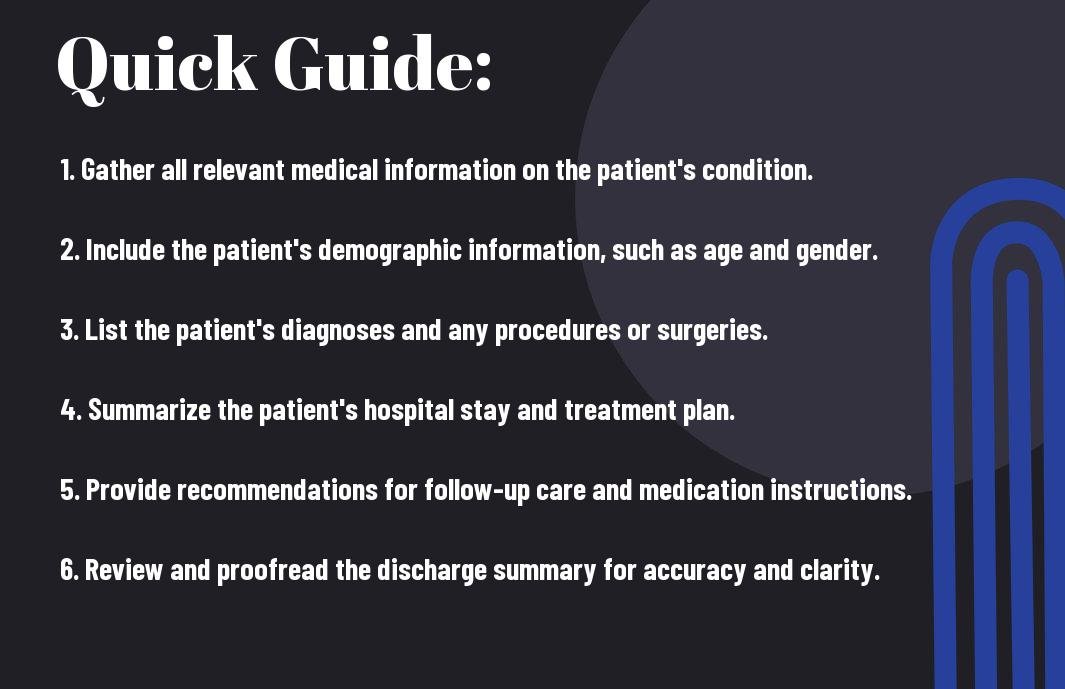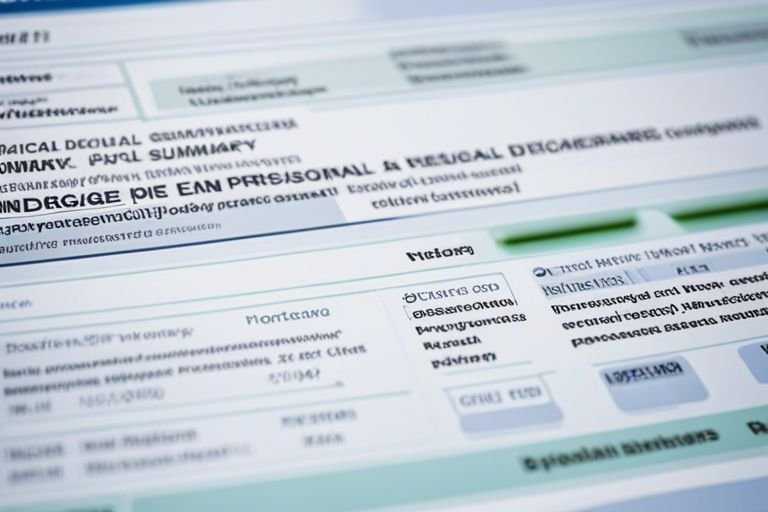As a healthcare professional, articulating a comprehensive and concise discharge summary is crucial for ensuring continuity of care for patients. In this guide, I will walk you through the essential components of a discharge summary, including the patient’s demographic information, hospital course, diagnoses, procedures, medications, and follow-up instructions. I will also provide valuable tips on how to effectively communicate the patient’s condition and treatment plan to the receiving provider, ensuring a smooth transition of care and minimizing the risk of medical errors. Whether you are a resident physician, nurse, or medical student, mastering the art of writing a discharge summary is an important skill that will contribute to the overall quality of patient care.
Key Takeaways:
- Components of a Discharge Summary: A discharge summary typically includes patient demographics, hospital course, reason for hospitalization, procedures and treatment received, discharge medications, follow-up plans, and other relevant information.
- Importance of Clarity and Conciseness: It is crucial to ensure the discharge summary is clear, concise, and organized, allowing for easy interpretation by other healthcare providers.
- Emphasis on Pertinent Medical Information: Focusing on pertinent medical information such as diagnosis, treatment, and follow-up instructions is essential in a discharge summary, as it serves as a key communication tool for the patient’s ongoing care.
- Key Tips for Writing a Discharge Summary: Some important tips include using standardized templates, avoiding medical jargon, being specific about the patient’s condition and treatment, and proofreading for accuracy and completeness.
- Understanding the Audience: It’s important to consider the audience of the discharge summary, which may include primary care physicians, specialists, and other healthcare providers involved in the patient’s care, ensuring the report is tailored to their needs.
Types of Discharge Summaries
A discharge summary can be classified into two main types: comprehensive discharge summaries and standard discharge summaries. A comprehensive discharge summary is a detailed and exhaustive report of the patient’s entire hospital stay, including the reason for admission, procedures performed, medications administered, and follow-up plans. On the other hand, a standard discharge summary is a more concise version of the comprehensive report, focusing on the essential aspects of the patient’s care and follow-up instructions.
Assume that
| Comprehensive Discharge Summaries | Standard Discharge Summaries |
| Detail-oriented | Concise |
| Include all procedures, medications, and follow-up plans | Focus on essential aspects of care and follow-up instructions |
| Lengthy | Shorter |
| Provides an in-depth overview of the patient’s hospital stay | Offers a brief summary of the patient’s care |
Comprehensive Discharge Summaries
A comprehensive discharge summary provides a detailed account of the patient’s medical history, current condition, hospital course, and discharge plans. This type of summary is essential for documenting complex cases and ensuring that the patient’s primary care physician has a thorough understanding of their hospitalization. It includes detailed information about the patient’s diagnosis, treatments received, test results, and plans for follow-up care. A comprehensive discharge summary is particularly important for patients with chronic conditions, multiple comorbidities, or complicated medical histories. It ensures that the receiving healthcare provider has all the necessary information to continue the patient’s care seamlessly.
Standard Discharge Summaries
A standard discharge summary is a more abbreviated version of the comprehensive report. It focuses on the essential aspects of the patient’s care, including their diagnosis, treatment, and follow-up instructions. While it may not provide the same level of detail as a comprehensive discharge summary, it is still crucial for ensuring continuity of care and communication between healthcare providers. The standard discharge summary outlines the patient’s condition at discharge, medications prescribed, recommended follow-up appointments, and any special instructions for the patient to follow post-discharge. It serves as a concise reference for the patient’s ongoing care and is vital for the coordination of their healthcare needs.
I hope this helps. Let me know if you need further assistance.
Tips for Writing a Discharge Summary
While writing a discharge summary, there are several tips that can help you create a comprehensive and effective report. Here are some key tips to keep in mind:
- Organize the information in a clear and logical manner.
- Use clear and concise language to convey important details.
- Include relevant information about the patient’s diagnosis, treatment, and follow-up care.
- Be thorough in documenting the patient’s medical history and current condition.
- Make sure to highlight any critical or dangerous findings that need immediate attention.
Knowing these tips will help you create an effective discharge summary that provides the necessary information for continued care.
Organizing Information Effectively
When writing a discharge summary, it’s important to organize the information in a way that makes it easy to follow. Start with the patient’s demographics and history, followed by the reason for admission, relevant medical history, hospital course, treatment, and discharge medications. This logical structure will help ensure that all essential details are included and easily accessible for the reader.
Using Clear and Concise Language
Using clear and concise language in a discharge summary is crucial for effective communication. Avoid using overly technical jargon or overly simplistic terms. Instead, strike a balance and use language that is easily understood by healthcare professionals and patients alike. This will ensure that the information is conveyed accurately and comprehensively.
Step-by-Step Guide to Writing a Discharge Summary
To ensure a comprehensive and accurate discharge summary, it is important to follow a structured approach. The information in the summary should be organized in a clear and concise manner, highlighting the most important details for the patient’s post-hospital care. Here is a step-by-step guide to help you write an effective discharge summary:
Gathering Patient Information
When gathering patient information for the discharge summary, it is crucial to include the patient’s demographic details, medical history, current diagnosis, and treatment plan. This information helps in providing a complete picture of the patient’s health status and guides the post-discharge care. Additionally, including any allergies, medications, and relevant test results is essential for the patient’s continued care and safety.
Structuring the Summary
Structuring the discharge summary is essential for clear communication of the patient’s medical status and post-discharge care plan. I recommend organizing the information into sections, such as an overview of the hospitalization, the patient’s medical history, current diagnosis, treatment received, discharge medications, follow-up instructions, and any necessary arrangements for ongoing care. By structuring the summary in this way, you ensure that all pertinent information is readily accessible to the patient and their healthcare providers.
Factors to Consider in Writing a Discharge Summary
For a comprehensive and effective discharge summary, there are several important factors to consider. These factors will help ensure that the summary is accurate, relevant, and helpful to both the patient and the healthcare team.
- Patient-specific details: This includes the patient’s medical history, current diagnosis, treatment plan, and follow-up instructions.
- Legal and ethical considerations: Writing a discharge summary also involves adhering to legal and ethical guidelines related to patient confidentiality and consent.
- Clarity and conciseness: The summary should be written in a clear and concise manner, using language that the patient can easily understand.
Recognizing and addressing these factors is crucial in producing a high-quality discharge summary that meets the needs of all parties involved.
Patient Specific Factors
When writing a discharge summary, the patient-specific factors should be the primary focus. This includes documenting the patient’s medical history, current diagnosis, treatment plan, and any important instructions for follow-up care. It is important to be thorough and accurate in detailing the patient’s condition and the care provided during the hospital stay. Assume that the summary will be used by other healthcare providers, and provide as much relevant information as possible.
Legal and Ethical Considerations
In addition to clinical details, it is important to consider legal and ethical considerations when writing a discharge summary. This includes ensuring that the patient’s privacy and confidentiality are maintained, and that all information is documented in compliance with legal requirements. It is also crucial to obtain patient consent for sharing their medical information, in accordance with ethical guidelines and regulations.
Pros and Cons of Different Approaches to Discharge Summaries
Despite the importance of discharge summaries in ensuring continuity of care for patients, different approaches to writing them have their own set of pros and cons. It’s essential to understand the different methods and their potential impact on patient outcomes.
| Approach | Pros and Cons |
| Comprehensive Summaries | Provides in-depth information about the patient’s medical history, current condition, treatment plan, and follow-up care. However, it may be time-consuming to create and review, leading to potential delays in the discharge process. |
| Standard Summaries | Offers a concise overview of the patient’s medical stay, making it easier to read and comprehend. On the downside, it may lack critical details that could impact post-discharge care and follow-up. |
Benefits of Comprehensive Summaries
Comprehensive summaries provide a detailed account of the patient’s medical journey, including their history, diagnosis, treatments, and instructions for follow-up care. This method ensures that healthcare providers have all the necessary information to continue the patient’s care effectively. It reduces the risk of miscommunication and medical errors, ultimately improving patient outcomes.
Drawbacks of Standard Summaries
While standard summaries offer a quick overview of the patient’s stay, they may not capture all the nuances of the patient’s condition. This could lead to gaps in information, potential misunderstandings, and inadequate post-discharge care. It’s crucial to recognize the limitations of standard summaries and consider the potential impact on patient safety and recovery.

Conclusion: How to Write a Discharge Summary – The Components and Tips of a Medical Report
With these considerations in mind, you should now have a better understanding of the key components and tips for writing a comprehensive and effective discharge summary. By including all relevant patient information, treatment plans, follow-up instructions, and ensuring clarity and accuracy in your documentation, you can provide valuable information to the patient’s next healthcare provider and contribute to continuity of care. Remember to use clear, concise language and avoid unnecessary jargon to ensure that your discharge summary is easily understood by all healthcare professionals involved in the patient’s care. By incorporating these elements into your medical reports, you can ensure that the transition of care is seamless and that the patient receives the best possible ongoing treatment.
FAQ
Q: What is a discharge summary in a medical report?
A: A discharge summary is a detailed document that outlines a patient’s medical history, diagnosis, treatments, and future care plans upon their discharge from a healthcare facility.
Q: What are the key components of a discharge summary?
A: The key components of a discharge summary include the patient’s demographic information, hospital course and reason for admission, significant findings, procedures and treatments, medications, discharge medications and follow-up care plans.
Q: How should a discharge summary be structured?
A: A discharge summary should be structured in a clear and organized manner, with sections for patient information, hospital course, significant findings, procedures and treatments, medications, discharge instructions, and follow-up care plans.
Q: What are some tips for writing a comprehensive discharge summary?
A: Some tips for writing a comprehensive discharge summary include using clear and concise language, including all relevant medical information, avoiding medical jargon, and ensuring that the document is easy to understand for both healthcare professionals and patients.
Q: Why is a well-written discharge summary important?
A: A well-written discharge summary is important because it provides crucial information about a patient’s medical history, treatments, and future care plans, which is essential for ensuring continuity of care and preventing medical errors during transitions between healthcare settings.

